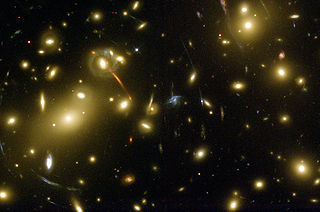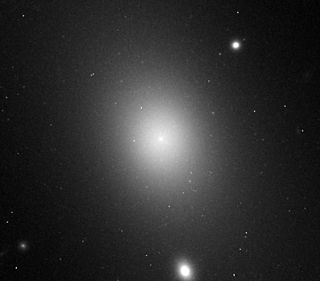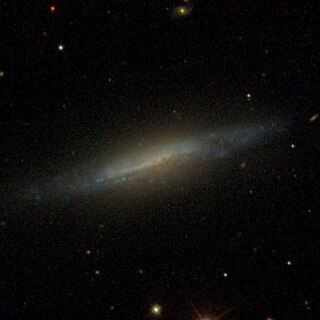Related Research Articles

A supercluster is a large group of smaller galaxy clusters or galaxy groups; they are among the largest known structures in the universe. The Milky Way is part of the Local Group galaxy group, which in turn is part of the Virgo Supercluster, which is part of the Laniakea Supercluster, which is part of the Pisces–Cetus Supercluster Complex. The large size and low density of superclusters means that they, unlike clusters, expand with the Hubble expansion. The number of superclusters in the observable universe is estimated to be 10 million.
The Sunyaev–Zeldovich effect is the spectral distortion of the cosmic microwave background (CMB) through inverse Compton scattering by high-energy electrons in galaxy clusters, in which the low-energy CMB photons receive an average energy boost during collision with the high-energy cluster electrons. Observed distortions of the cosmic microwave background spectrum are used to detect the disturbance of density in the universe. Using the Sunyaev–Zeldovich effect, dense clusters of galaxies have been observed.

Abell 2218 is a large cluster of galaxies over 2 billion light-years away in the constellation Draco.

Halton Christian "Chip" Arp was an American astronomer. He was known for his 1966 Atlas of Peculiar Galaxies, which catalogues many examples of interacting and merging galaxies, though Arp disputed the idea, claiming apparent associations were prime examples of ejections. Arp published Seeing Red: Redshift, Cosmology and Academic Science in 1998. Arp was also known as a critic of the Big Bang theory and for advocating a non-standard cosmology incorporating intrinsic redshift.
Redshift quantization, also referred to as redshift periodicity, redshift discretization, preferred redshifts and redshift-magnitude bands, is the hypothesis that the redshifts of cosmologically distant objects tend to cluster around multiples of some particular value.

IC 1101 is a class S0 supergiant (cD) lenticular galaxy at the center of the Abell 2029 galaxy cluster. It has an isophotal diameter at about 123.65 to 169.61 kiloparsecs. It possesses a diffuse core which is the largest known core of any galaxy to date, and also hosts a supermassive black hole that is one of the largest black holes known. The galaxy is located at 354.0 megaparsecs from Earth. The galaxy was discovered on 19 June 1790, by the British astronomer William Herschel.
Edmund Bertschinger is an American theoretical astrophysicist and cosmologist and professor of physics at MIT.

Georges Meylan is a Swiss astronomer, born on July 31, 1950, in Lausanne, Switzerland. He was the director of the Laboratory of Astrophysics of the Swiss Federal Institute of Technology (EPFL) in Lausanne, Switzerland, and now a professor emeritus of astrophysics and cosmology at EPFL. He is still active in both research and teaching.

The Coma I Group is a group of galaxies located about 14.5 Mpc (47.3 Mly) away in the constellation Coma Berenices. The brightest member of the group is NGC 4725. The Coma I Group is rich in spiral galaxies while containing few elliptical and lenticular galaxies. Coma I lies in the foreground of the more distant Coma and Leo clusters and is located within the Virgo Supercluster.

NGC 708 is an elliptical galaxy located 240 million light-years away in the constellation Andromeda and was discovered by astronomer William Herschel on September 21, 1786. It is classified as a cD galaxy and is the brightest member of Abell 262. NGC 708 is a weak FR I radio galaxy and is also classified as a type 2 Seyfert galaxy.

NGC 4093 is an elliptical galaxy located 340 million light-years away in the constellation Coma Berenices. The galaxy was discovered by astronomer Heinrich d'Arrest on May 4, 1864. NGC 4093 is a member of the NGC 4065 Group and is a radio galaxy with a two sided jet.

The NGC 4065 Group is a group of galaxies located about 330 Mly (100 Mpc) in the constellation Coma Berenices. The group's brightest member is NGC 4065 and located in the Coma Supercluster.

NGC 1161 is a lenticular galaxy approximately 90 million light-years away from Earth in the constellation of Perseus. It was discovered, along with NGC 1160, by English astronomer William Herschel on October 7, 1784.

NGC 3937 is an elliptical or a lenticular galaxy located about 310 million light-years away in the constellation Leo. It was discovered by astronomer William Herschel on April 27, 1785 and is classified as a radio galaxy.

AP Librae is a BL Lacertae object located at a distance of 700 million light years in the southern constellation of Libra. In the visual band it is one of the most active blazars known. AP Lib is surrounded by an extended source with a spectrum characteristic of a red-shifted giant elliptical galaxy. The derived visual magnitude of this region is 15.0, and it follows a radially decreasing brightness that is characteristic of an elliptical. Seven fainter galaxies are visible within an angular radius of 9′, suggesting it is the brightest member of a galactic cluster.

NGC 4359 is a dwarf barred spiral galaxy seen edge-on that is about 56 million light-years away in the constellation Coma Berenices. It was discovered by astronomer William Herschel on March 20, 1787. It is a member of the NGC 4274 Group, which is part of the Coma I Group or Cloud.
The Southern Supercluster Strand is a galaxy filament that incompasses the Southern Supercluster and the Telescopium−Grus Cloud.
References
- ↑ William G. Tifft's Personal Web page at the U. Arizona
- ↑ "William Tifft". 14 June 2014.
- ↑ "Tifft, William G. (1958-01-01) Multicolor photoelectric photometry of bright extragalactic systems. http://resolver.caltech.edu/CaltechETD:etd-01192006-093239". etd.caltech.edu. Archived from the original on 17 February 2007. Retrieved 14 January 2022.
{{cite web}}: External link in|title= - ↑ W. G. Tifft (1976). "Discrete states of redshift and galaxy dynamics. I - Internal motions in single galaxies". Astrophysical Journal. 206: 38–56. Bibcode:1976ApJ...206...38T. doi:10.1086/154354. hdl: 10150/627259 .
- 1 2 W. G. Tifft (1977). "Discrete states of redshift and galaxy dynamics. II - Systems of galaxies". Astrophysical Journal. 211: 31–46. Bibcode:1977ApJ...211...31T. doi:10.1086/154901. hdl: 10150/627260 .
- ↑ W. G. Tifft (1977). "Discrete states of redshift and Galaxy dynamics. III - Abnormal galaxies and stars". Astrophysical Journal. 211: 377–391. Bibcode:1977ApJ...211..377T. doi:10.1086/154943. hdl: 10150/627261 .
- ↑ Martin R. Croasdale (1989). "Periodicity in Galaxy Redshifts". Astrophysical Journal. 345: 72–83. Bibcode:1989ApJ...345...72C. doi: 10.1086/167882 .
- ↑ W. M. Napier & B. N. G. Guthrie (1997). "Quantized Redshifts: A Status Report" (PDF). Journal of Astrophysics and Astronomy. 18 (4): 455–463. Bibcode:1997JApA...18..455N. doi:10.1007/BF02709337. S2CID 73557034.
- ↑ H. Arp (1986). "A corrected velocity for the local standard of rest by fitting to the mean redshift of local group galaxies". Astronomy and Astrophysics. 156: 207–212. Bibcode:1986A&A...156..207A.
- ↑ H. Arp (1987). "Additional members of the Local Group of galaxies and quantized redshifts within the two nearest groups". Journal of Astrophysics and Astronomy. 8 (3): 241–255. Bibcode:1987JApA....8..241A. doi:10.1007/BF02715046. S2CID 119819755.
- ↑ Dava Sobel, "Man stops universe, maybe - William Tifft believes the universe may not be expanding", Discover, April, 1993)